Answering The "What If?": The SFJAZZ Resident Artistic Directors Program
June 26, 2018 | by Richard Scheinin
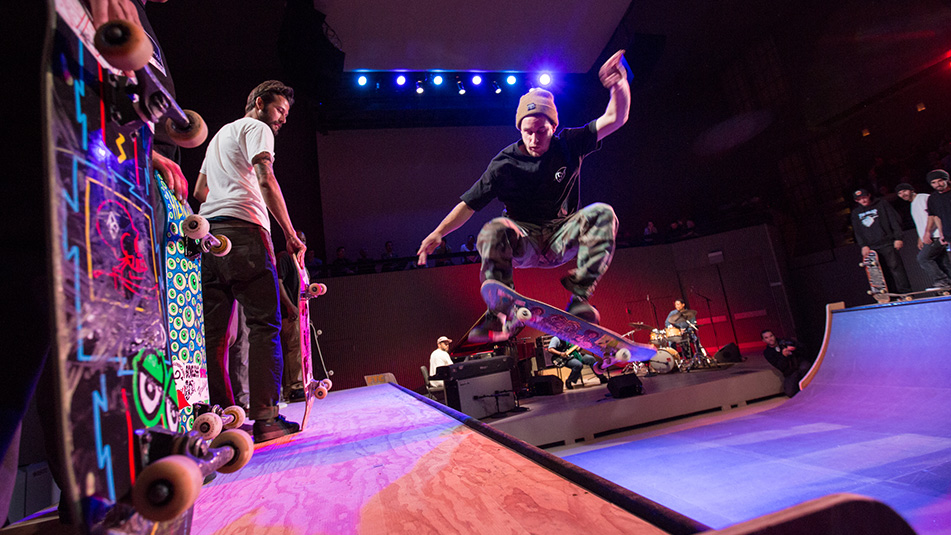
Jason Moran's "Jazz + Skateboarding" at SFJAZZ (Photo by Scott Chernis)
This is how it works.
Every two years, SFJAZZ anoints a group of Resident Artistic Directors, inviting each to dream up two full weeks of programs over the course of two seasons. It’s a carte blanche invitation, a challenge to do something unexpected – maybe something they’ve always thought about doing, but dismissed out of hand because it seemed too time-consuming, too expensive, too impractical or outlandish. Ever since this exercise in imagination began in 2013, unexpected programs have come to life at the SFJAZZ Center. Trumpeter Terence Blanchard presented his opera, Champion, about the boxer Emile Griffith. Drummer Eric Harland staged a Super Bowl party around Madden NFL Football, the video game, interacting musically with a pair of professional gamers, Mr. Finesse and Panoramic. Pianist Jason Moran – who grew up skateboarding in Houston – convinced SFJAZZ to install a half-pipe in front of the stage and invited nine of San Francisco’s best skaters to collaborate with his group, the Bandwagon. It was a new kind of jam session: You could feel the musicians feeding off the skaters’ energy, their rhythm and flow.
An artist is more kaleidoscopic than monolithic. People forget that artists have many voices.
Jason Moran
An unlikely meeting of two subcultures, jazz and skateboarding, the program was so successful that the pianist has since taken it on the road, repeatedly. But without that carte blanche invitation, it may never have happened. For a musician to be handed such freedom is “extremely rare,” Moran says. “And that’s what makes it exciting – when an organization offers so much support to an artist, and when they’re aware that an artist is more kaleidoscopic than monolithic. People forget that artists have many voices, and just because you know someone as a jazz bassist, that doesn’t mean that’s all he wants to be.”
The bar has been set for whoever comes next.
Not that Laurie Anderson is worried about clearing the creative hurdle; out-of-the-box is who she is.
One of five incoming Resident Artistic Directors this season – the others are pianist Chucho Valdés, vocalist Dianne Reeves, saxophonist Joe Lovano and bassist Marcus Shelby – she has begun dreaming up her first week of programs (Nov. 29-Dec. 2), which will include an evening at Grace Cathedral. There she will stage "The Drones," leaning six of her late husband Lou Reed’s guitars against half a dozen amplifiers, filling the church with oscillation and hum, creating a warm sonic bath for listeners who, she predicts, “will become kind of helpless, sliding down the walls and onto the floor with all those beautiful overtones and waves.”
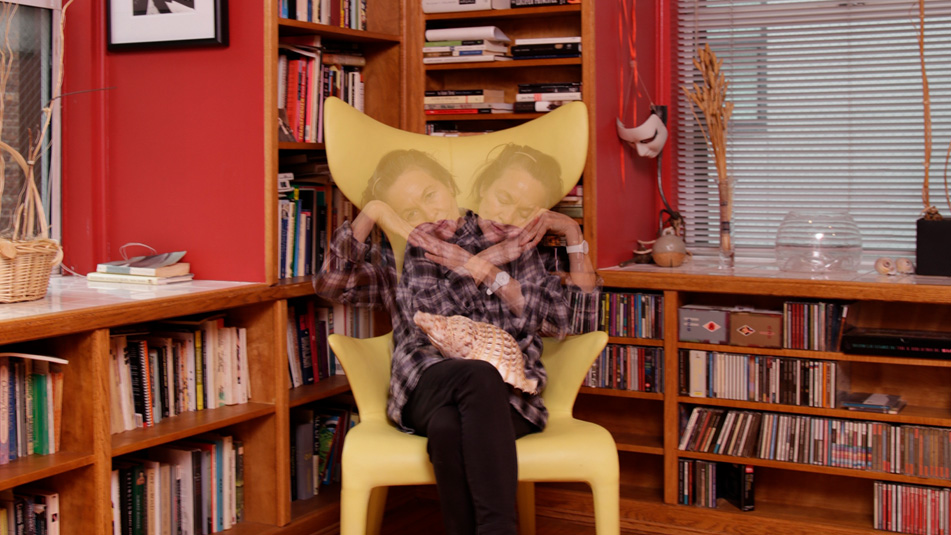
Laurie Anderson
A multi-media avant-gardist, composer, violist and filmmaker, Anderson is open to the creative jump-cut: “Maybe because I’m working in a lot of distant disciplines – painting, sculpture – I’m not so afraid of changing forms and formats,” she says. “An aria followed by a guitar solo? That’d be great!”
Looking for surprises, she has chosen to collaborate with two of the Bay Area’s best-kept secrets: pianist Tammy Hall and drummer Scott Amendola, musicians who intrigue her but with whom she has never before played one note. With Hall, she will perform a night of "Songs for Women," and with Amendola a night of "Songs for Men." With her old friend Fred Frith, the guitarist and composer, she will present “Scenes from My Radio Play” – to be intoned in the dark, though she doesn’t quite explain why. “I’m just trying to jump in and see what I can stir up,” she offers. “Basically you invite all your friends over to play and try to make the situations that create the most fun.”
Marcus Shelby, whose first residency arrives at the tail end of the 2018-19 season (May 23-26), takes a different approach. He is a long-range planner, assiduously assembling a vision ever since he moved to San Francisco in 1996. He teaches in schools and prisons, collaborates with theater companies, filmmakers and poets and has composed a triptych of big band suites drawn from African-American history. His Port Chicago (2006) was inspired by the 1944 explosion at an East Bay naval yard, where more than 320 men were killed, most of them black American sailors. His Bound for the Promised Land: Harriet Tubman suite (2007) evoked the Underground Railroad’s abolitionist hero. His Soul of the Movement (2011) drew on the legacy of Martin Luther King Jr., while exploring work songs, spirituals, blues, jazz and Curtis Mayfield’s “We’re a Winner.”
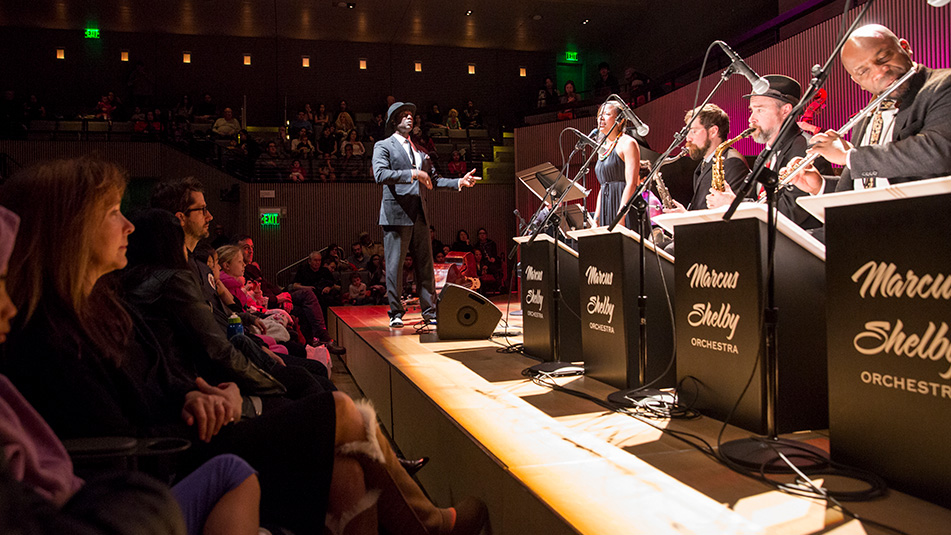
The blues will beat at the heart of Shelby’s ambitious residency.
It will include two shows built around the blues and swing of Duke Ellington, Shelby’s hero. He will collaborate with author Daniel Handler (a.k.a. Lemony Snicket) for a blues-infused celebration of San Francisco and its neighborhoods. Shelby will go deep with a program titled "Blues Legacies and Black Feminism," named for the 1999 book by Angela Davis, the activist and academic, who will join the bassist on stage for a night of words and song, putting a special focus on the legacies of “Ma” Rainey, Bessie Smith and Billie Holiday. Shelby calls the book “the most articulate treatise on the blues; this book just blew my mind many years ago. And I had no idea I would ever meet Angela Davis, but when SFJAZZ asked me what I’d like to do, I said I’d like to turn her book into a historical piece with a singer and with my band and with Angela Davis herself. She’ll speak, we’ll play, and we’ll take it back and forth, putting blood and flesh to this book, setting it on its feet as a theatrical presentation. I still can’t believe it.”
You may not believe what else Shelby is preparing for his residency: an extended composition for big band titled “Black Ball: The Negro Leagues and the Blues.” Shelby is a baseball freak, an avid fan of the San Francisco Giants, and he intends to combine his love of the game with his passion for history. He draws connections between the barnstorming teams of the old Negro Leagues and the barnstorming territory bands of the swing era. He notes that Negro League games were entertainments, replete with clowns and comedic outbursts of “shadow ball,” where an invisible baseball would be whipped around a fictitious diamond. All this showmanship, mediated by the blues, will play out onstage, Shelby promises. He adds this: “When people are asked, ‘What is the authentic American invention,’ they tend to say it’s the Constitution. But I really think it’s baseball and the blues.”
As you can tell, when an artist is awarded a Resident Artistic Directorship, it tends to uncork a lot of pent-up energy and ideas. It’s been only five years since the directorships were first handed out, but they are the logical outcome of programming experimentation that goes back decades.
I look forward to creating some music within the music, with the people and for the people, every night.
Joe Lovano
In 1983, when SFJAZZ – then known as Jazz in the City – presented its first shows, it suffered a few hiccups. Randall Kline, the organization’s founder and executive artistic director, recalls putting on festival-style concerts that would bring together, say, an Afro-Cuban band, a Brazilian drum troupe and a screaming group of free-jazz saxophonists. Ticket sales for one-off shows with that kind of stylistic spread didn’t necessarily take off.
“So in our second year, we started to focus the programs in more specific stylistic areas,” he explains. “We’d do an avant-garde show. We did a great Afro-Cuban show. And we found that adding this little bit of context helps everybody. It helps the people who are already into that niche, and it helps the people who are outside of it to understand it a little bit. It became this evolutionary thing for us, where we kept building on this idea of having thematic ideas as the basis of what we do.”
When SFJAZZ instituted its first Spring Season in 2000, Kline hired saxophonist Joshua Redman as Artistic Director. The idea that Redman, a Bay Area-bred jazz star, was on board, fashioning programs that reflected his own perspective on jazz – this proved attractive to audiences. Redman stayed in the job through 2007, and his influence was considerable; it made the programs feel personal.

When you jump into a new situation, you find parts of yourself that you didn’t even know existed.
Dianne Reeves
When the SFJAZZ Center opened in 2013, the decision was made to expand on this sensibility: Why have one artist’s perspective when you could have five? And so the Resident Artistic Director program was born: “It made sense,” Kline reflects. “You can get all these different points of view, which is what we’ve always been about -- having this broad interpretation of what jazz is or what jazz can be. So you call Jason Moran and he says, ‘What about skateboarding?’ Perfect! Or you call Bill Frisell and you say to him, ‘Are you game for this?’ And he doesn’t have four ideas, he has twenty.”
Like Moran, guitarist Frisell was a member of the first class of Resident Artistic Directors. So was John Santos, the San Francisco-based percussionist, who has made a career of dreaming up projects that connect musicians from across the African diaspora.
Santos is a scholar of Afro-Caribbean music. He is also a working musician on a mission, looking to create synergies between players and to expose audiences to the hidden corners of the tradition. When Santos thinks back to his two-year residency, his voice pulses with excitement. From Spain, he was able to bring Pavel Urkiza, not particularly well known in the United States, though he is an “incredible songwriter, a composer, arranger, guitarist, vocalist and producer and a force of nature, an orchestra by himself.” From New York he recruited the great trombonist Papo Vazquez -- and Paquito D’Rivera, the legendary saxophonist and clarinetist, which was a dream for Santos. “Because normally, I could never just call Paquito. I couldn’t just pick up the phone and say, ‘Hey, how’d you like to come out for a show next month?’ But Randall knew his manager. Doors were opened. It gives you an open palette, and you can paint whatever musical picture you want. It allows you to do more.
Chucho Valdés – among the leading Cuban musicians of the past half-century – will bring more than his regular band to his upcoming residency (Jan. 31-Feb. 3). He will introduce a new edition of Irakere, the groundbreaking ensemble he founded in 1973; D’Rivera and trumpeter Arturo Sandoval were among its original members. Much as Ellington composed for Johnny Hodges and Cat Anderson, pianist Valdés composed for his own singular soloists. There was nothing like it: The group was a laboratory where traditional Yoruban and deep-African folk forms merged with jazz, fusion and pop – driven by a tsunami of percussion.
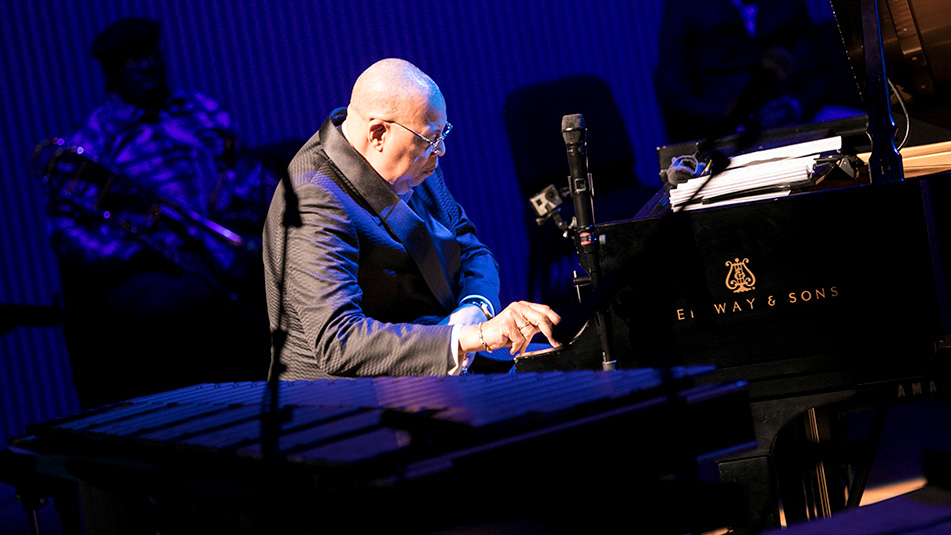
Chucho Valdés performing at the SFJAZZ Gala 2018 honoring Preservation Hall
To mark the 45th anniversary of the group’s founding, Valdés will lead Irakere 45 – that’s what he calls the band -- for four nights. They will play classic numbers and new compositions, perhaps including a tango he’s written for his wife Lorena. What’s more, Valdés is entertaining the notion of holding competitions for high school and conservatory musicians in Havana and San Francisco. The two winners – one in each city – just might sit in for a few numbers with the 10-piece band, already stocked with virtuosi half their leader’s age. “Surprises are bound to happen,” Valdés predicts, speaking through a translator. “This makes it a learning experience for me… and it becomes a kind of master class for the audience – the information they receive will be very different from the message they expected.”
“When you jump into a new situation, you find parts of yourself that you didn’t even know existed,” says vocalist Dianne Reeves, whose residency (Feb. 21-24) will nurture her love of Brazilian music. She sounds thrilled: singer-songwriter Ivan Lins will be among her guests. His melodies are uncontainable; that’s what audiences latch onto. He is a master of harmony; musicians love that about his tunes. Reeves reflects on the possibilities: “You come into contact with a person’s harmonic vocabulary or rhythmic vocabulary or their melodic sense – suddenly you’re hearing the way they hear things, and they’re hearing the way you hear things. Anything can happen. That’s why I call my stage a playground.”
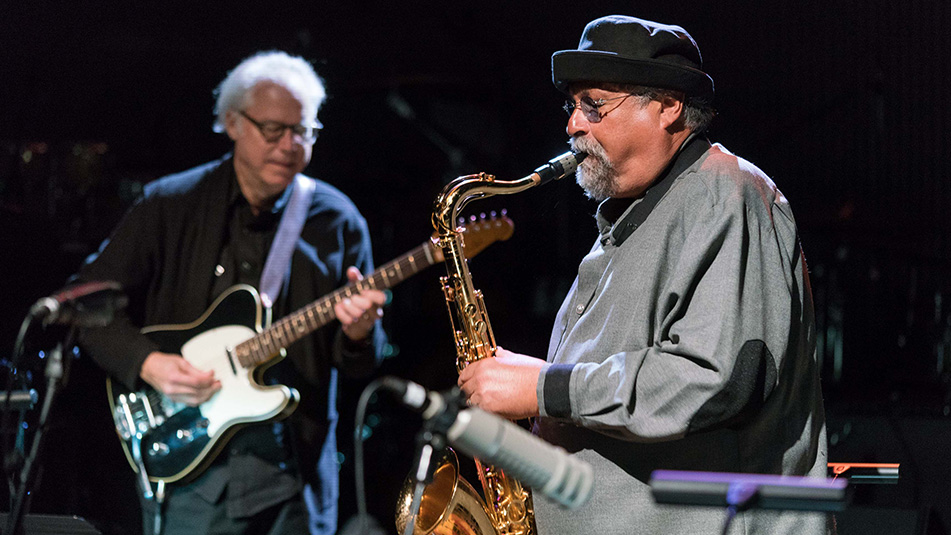
Joe Lovano and Bill Frisell at SFJAZZ in the 2016-17 Season
Such sophisticated play is what Joe Lovano is about. The saxophonist’s residency (March 14-17) feels like a summation of his free-roaming creative tendencies: He will play in a duo with Chucho Valdés; in a trio with Bill Frisell; in a “Tenor Legacy” sextet with Joshua Redman and Ravi Coltrane; and in a bebop nonet – his 52nd Street Themes band – with saxophonists Gary Smulyan and Ralph Lalama. Aside from the fact that Lovano enjoys juggling projects, there is an underlying theme here: All these musicians are his friends.
Example: For 30 years, Frisell was Lovano’s bandmate in drummer Paul Motian’s trio, where they learned “to share the space and create the music within the music.” He has known Redman for a couple of decades – and also knew his dad, Dewey Redman, whose earthy sound got into the marrow of Lovano’s own playing long ago. Likewise, Lovano has known Ravi Coltrane for 20 years or more – ever since the younger saxophonist arrived in New York and began playing with drummer Rashied Ali, who had played with John Coltrane, Ravi’s father. Coincidentally, Lovano was in Ali’s band, too.
It all comes full circle.
“I live in the world of music,” Lovano concludes, “and what I’ve come to realize is that when I present an ensemble, whether it’s two pieces or nine pieces, it’s all the same. It’s all one. I look forward to creating some music within the music, with the people and for the people, every night.”
- RS
A staff writer at SFJAZZ, Richard Scheinin is a lifelong journalist. He was the San Jose Mercury News' classical music and jazz critic for more than a decade and has profiled scores of public figures, from Ike Turner to Tony La Russa and the Dalai Lama.
